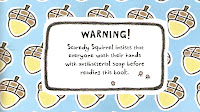The Great American Trickster: Two Wileys and That Hairy Man
 With the arguable exception of Br'er Rabbit, American folk literature's top trickster has got to be the wily Wiley, who with his mama's help, manages to fool that old conjurin' sack man three times in Wiley and the Hairy Man.
With the arguable exception of Br'er Rabbit, American folk literature's top trickster has got to be the wily Wiley, who with his mama's help, manages to fool that old conjurin' sack man three times in Wiley and the Hairy Man. According to the retellers' notes, this story was collected somewhere in central Alabama by Donnell Van de Voort and published in the "Manuscripts of the Federal Writers' Project of the Works Progress Administration for the State of Alabama." Although Wiley has roots in African folklore, the tale is a fully American "confabulation" in which the plucky boy and his mother use their natural-born sass and wit to rid themselves of a cloven-footed swamp bogeyman.
The tale of Wiley is available currently in two stand-alone versions, both with much to recommend them to the reader or teller. The more recent adaptation, that of Judy Sierra and the Caldecott award-winning artist Brian Pinkney, published in 1996, shows off Pinkney's beautiful oil paintings on scratchboard, featuring jewel-like blues, greens, and golds. Sierra's retelling, which perhaps includes more of the orginally recorded version from the 1930's, is more conversational and meandering, a strong adaptation whose longer text provides ample room for Pinkney's sensuous illustrations to spread out on the large pages. The older and, to my mind, more satisfying version, however, is the edition retold and illustrated by Molly Garrett Bang, known for her more recent Caldecott book, When Sophie Gets Angry--Really, Really Angry.
The older and, to my mind, more satisfying version, however, is the edition retold and illustrated by Molly Garrett Bang, known for her more recent Caldecott book, When Sophie Gets Angry--Really, Really Angry. Amazingly, Bang's powerful version was written as a controlled vocabulary Ready-to-Read edition (Simon & Schuster, 1976), illustrated in her simple but realistic black and sepia drawings. Perhaps the limited language is an asset to the storyteller in this iteration. Although Bang's text is not in dialect, its simplicity and word selection sound authentic to my Alabama-born ear, and in the reading it is easy to fall into a slow Southern cadence which befits the setting. The few but choice words give the text great drama when read aloud, and the suspense leading up to Wiley's and Mama's final tricks will mesmerize any audience:
Then the Hairy Man said,
"I'll dry up your cow.
I'll dry up your spring.
I'll send a million boll weevils out of the ground to eat up your cotton if you don't give me your young 'un.
"Hairy Man," said Wiley's mother, "you wouldn't do all that.
That's mighty mean."
I'm a mighty mean man," said the Hairy Man.
Bang's illustrations are equally strong in evoking the swampy atmosphere. Wiley, in his cutoffs and outgrown shirt, is skinny and long-limbed, and his thin, wiry mother, dressed in a long, skimpy work dress and kerchief, never stops working even as she shares her conjure wisdom with her only son. The Hairy Man himself is a marvelous bogeyman, short and powerfully squat, with a cow's tail and hind feet, and a smugly smiling mouth bristling with long snaggly teeth, his body language full of self-satisfied power until his final comeuppance.
A truly American trickster, the fearful but courageous underdog whose wit sees him through, Wiley is a national treasure, a reminder that size and power and sheer meanness don't always prevail over a hero who knows just how to use what he's got.



























